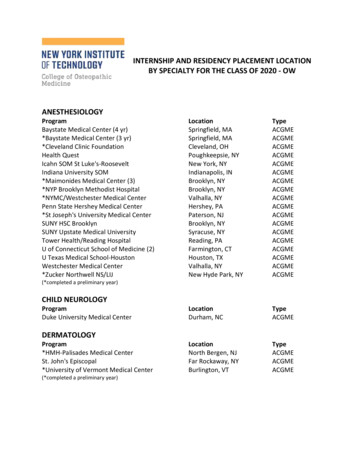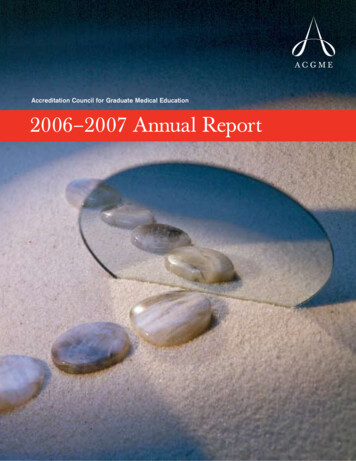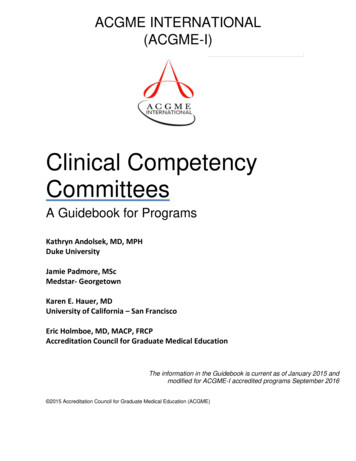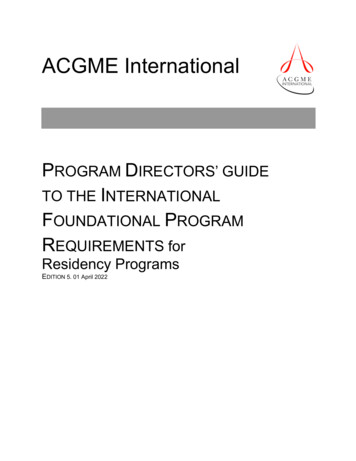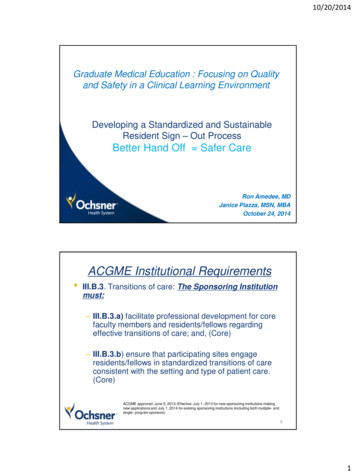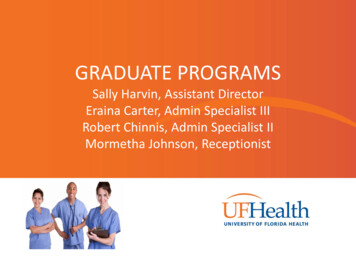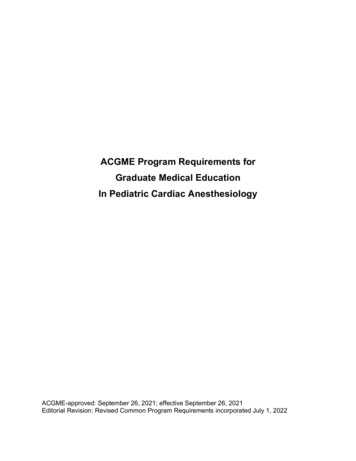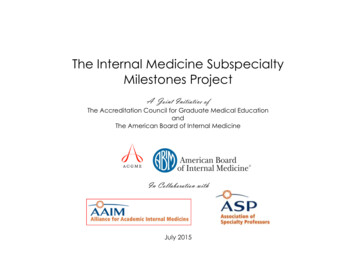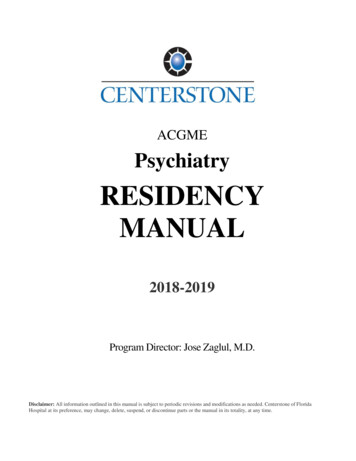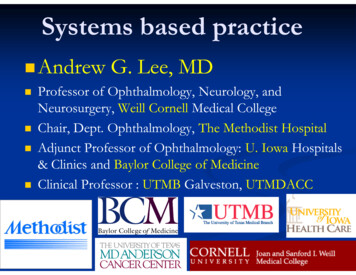
Transcription
Systems based practice Andrew G. Lee, MDProfessor of Ophthalmology, Neurology, andNeurosurgery, Weill Cornell Medical CollegeChair, Dept. Ophthalmology, The Methodist HospitalAdjunct Professor of Ophthalmology: U. Iowa Hospitals& Clinics and Baylor College of MedicineClinical Professor : UTMB Galveston, UTMDACC
I have no relevant financial interest inthe contents of this talkDisclosuresPI: American GeriatricsSociety GSIPI: Lilly NAION studyStock: Credential ProtectionAdvisory Board: Alcon,Cataract education in ChinaReviewer: NASA, VIIPstudy sectionHonorarium: NoneSpeakers bureau: None
Relevant Disclosures Dr. Lee is a member of the Residency ReviewCommittee (RRC(RRC)) for OphthalmologyACGME Ophthalmology Milestones Working GroupExaminer/prop writer for the American Board ofOphthalmology (ABO(ABO)) & OKAP test writing committeeResidency Education Committee (REC(REC)) for theAmerican Academy of Ophthalmology (AAO(AAO))Association of University Professors of Ophthalmology(AUPOAUPO)) Fellowship Compliance CommitteeThe views expressed here do not reflect those ofRRC, ACGME, OKAP, ABO, REC, AAO, or AUPO
Start with a philosophical question Why are you here .?
These talks contain information of a graphic nature and some materialmay be inappropriate for unengaged learners.You will be asked tomake a behavior change at the end. Viewer discretion is advised.
Women in audience close your eyes .Men:What do you see (keep it to yourself for now)?
OK, now men cover your eyes. Women: Whatdo you see (keep to yourself for now)?
What did you see?Men? Women?How much would you bet that the other person is wrong?How strongly would you argue the point?
Remember this the next time youget in a fight with .
Objectives Definesystems based practice (SBP) Describe your system(s) of care Encourage you to commit to usingsystems based practice & learning End with a practical real worldrecommendation
Defining Systems based competency:ACGME perspective Systems--Based PracticeSystemsAwareness of and responsiveness to larger context &system of health care Ability to effectively call on system resources toprovide care that optimal i.e., Work within the health care system
Systems based care Micro-system of care (your clinic, your office, the O.R.)MicroSmall macromacro-system (your hospital, your state)Large macromacro-system (Medicare, US health care system, Payfor Performance)
Which part of system are you on?WeightlossFUONAIONTMJPMRHeadache
The artery on the side of my headhurtsI have GCA
Initial symptoms in GCA (n 100)PMRFUOTVL
Why do we still miss GCA?
The elephant in the room
How many systems can you find? sTeamwork with nursing, labs, radiologyPharmacyReferring & primary care doctors
Systems based practice patientsafety
It takes a village Parking attendantRegistrationEmergency roomNurseTechnicianResident or fellowLabRadiologyReferring doctorSocial workerPATIENT
Systems--based practice team workSystems
When I was a resident .Our busy operating room inophthalmology Cataract surgery day Two patients Mary Smith (not real names) Mary K. Smith Mary L. Smith Wrong intraocular lens in BOTH patients
Maria Garcia is a super commonname at Ben Taub Hospital HCHD patients database:3,428,925 2 pts same last & first names: 249,213 4 share same last & first names: 76,354 2 same last & first name & dob: 69,807Maria GarciasGarcias::2,488Maria Garcias with same date of birth: 231
Challenge question Whatshould we do with our nextMaria Garza patient? What is your system for avoidingwrong patient, wrong name, samename, wrong medication, wrong sitesurgery ?
United flight 232 United flight 232 Denver to ChicagoJuly 19, 1989Captain Al Haynes: 30,000 hour pilotFirst Officer Records & Engineer DvorakEight flight attendants285 passengers on board DCDC-10
Uh Oh Somewhere over IowaFan broke apart, lost #2 engineNo hydraulicsPlane can not fly withouthydraulicsSioux City had an open runwayCapt. Haynes kept his coolCapt. Haynes formed a team
Team building Passenger on board: Dennis Fitch, a Unitedtraining & check pilot3,000 hours on DCDC-10They could only turn rightThey had no controlsThey used the engine thrust to steerThis had been done once before in Japan (Fitchhad studied it)
Capt Fitch meet Capt Haynes Transcript of meeting of Captains in cockpitHaynes: “My name's Al Haynes”Fitch: “Hi, Al. Denny Fitch”Haynes: “How do you do, Denny?”Fitch: “I'll tell you what. We'll have a beer whenthis is all done”Haynes: “Well, I don't drink, but I'll sure as hellhave one.”
Transcript for the approach Sioux City Approach: United two thirtythirty-two You're cleared to land on any runway.Haynes: [Laughter] Roger. [Laughter] You wantto be particular and make it a runway, huh?
Initially pointed to Des Moines thenSioux City, Iowa
The plane crash landed but landed 111 diedBut 185 survivedIncluding Captain Haynes
After the accident 57 flight crews could not replicate the landing inthe simulator
Challenge question: What shouldwe do now?1.2.3.4.Congratulate Captain HaynesMake a charitable donation in his nameAvoid flyingPerform a root cause analysis
Root cause analysis Fracture of fan diskFailure of maintenance process to detect crackMetal 'inclusion' in diskDefect traced back to metal processing plantDefect in elimination of gaseous anomaliesduring purifying of (molten) titanium disk ingotNewer batches used a 'triple vacuum' process toeliminate these impurities.
The fan failed
Fan reconstructed
Examples: Quality Assurance Systems based carePatient safetyReduce medical errorsReduce medication errorsEliminate wrong site surgeryCompetency ToolsNear miss analysisRoot cause analysisResident porfolio projectsSelf--reflection exercisesSelf
Reason’s Swiss cheese
Active failures vs. latent conditions
Alignment of the holes leads tooutcome of error
Culture change: Don’t blame the lastslice of cheeseMiddle of night ER visitNo formalVisual fieldsat nightRadiologyOrder formDiscuss withradiologyStroke patientDischarged with“normal CT”Look at filmsResidentFacultyRadiologyresident
We are all responsible for patientsafety
Jesica Santillan
Jesica Santillan’s story Congenital restrictive cardiomyopathyTransplant was her only hope of survivalFather was a truck driver near Guadalajara,Mexico (illegal immigrants to USA)North Carolina businessman adopted her cause
Feb 6, 2003 Carolina Donor Services (CDS) offers transplantableheart to Duke (middle of night)First potential recipient was not ready for transplantDoctors asked if organs might be available for JesicaOrgan procurement coordinator offers to check thisand call back, and when they did .Doctors assumed that CDS wouldn't have called backand released the organs unless they were a matchThis was a wrong assumption
The rest of the story Organs brought to Duke (Known Type A)Following implantation of organs(approximately 10:00 p.m.), surgical teamreceived a call from Duke's Clinical TransplantImmunology Laboratory reporting organs wereincompatible with Jesica's blood type (Type O)Despite aggressive treatment & a secondtransplant, Jesica died
Multiple holes in the Swiss Cheese Organ Procurement didn’t ask if matchedHarvesting surgeon knew Type was A butassumed it was a matchDr. Jaggers knew patient was Type O butassumed donor was a match12 doctors came into contact with this chart butnone noticed the mismatch
It isn’t about bad hospitals 2001: Johns Hopkins All 2,400 federallyfinanced experiments shut down because EllenRoche died after inhaling hexamethonium in anasthma experiment1995 Memorial SloanSloan-Kettering: chiefneurosurgeon operated on wrong side1994 Dana Farber Cancer Ctr: Overdose ofchemotherapy for breast cancer
Human errors in the ICU Crit Care Med 1995;23:2941995;23:294-300. Donchin et al.4 months observation timeAverage of 178 activities per patient per dayEstimated 1.7 errors per patient per daySevere or potentially detrimental error occurredon average twice a dayPhysicians and nurses were about equalcontributors to the number of errors
Translation: Not good enough ICU function 99% level of proficiencyA 99.9% proficiency rating2 unsafe landings at O'Hare airport everyday 16,000 pieces of lost mail every hour 32,000 bank checks directed from the wrong bankaccount every hour Error in Medicine, JAMA, 272:1851,1994.
A true story of my own . 65 y/o WM with optic neuropathyMRI, labs, chest xx-ray orderedScheduled follow up in 3 weeksPatient did not return for follow upMRI reviewed and normal on reportLabs in electronic record report (IPR) negative
3 months later Chest xx-ray report appears in my electronicmailbox (months later): “Right upper lungnodule”Patient had moved to New JerseyOld number & address were disconnectedNo forwarding number or address in EMR
Now what .
Name the system errors Resident ordering study did not get chest xray toreview at roundsFaculty did not review x ray (did not know itexisted!)Electronic reporting did not put report in in boxRadiologist did not callThree month delay was not flagged
The rest of the story Found patient’s brother in IowaCalled patient in New JerseyDisclosed situation by phoneCalled patient’s new primary doctor in NJRepeat chest film showed .No change, benignnoduleWhew!.
System improvements Work rounds listLetter to no showsLook up dictation for no showsRadiology instructed to call for lung nodulesIPR back log flags
What is your system for tracking labs andradiographs? When you have a sentinelevent do you do a root cause analysis?
"Every system is perfectly designedto achieve the results it does."Don Berwick: Institute for Health Care Improvement
The story of Patrick Patrick Reynolds is an antianti-smoking advocateFoundation for a smoke free AmericaPatrick’s father died from smoking related COPDPatrick’s brother died from smoking related COPDPatrick’s aunt died from stomach cancerPatrick’s grandfather died of pancreatic cancerAll were tobacco usersThat’s not the interesting part
Patrick is antismokingbecause . Patrick’s brother was R.J. Reynolds IIIPatrick’s father was R.J. Reynolds, Jr.Patrick’s grandfather was R.J. ReynoldsReynold’s (Camel, Kool, Doral, Winston, Salem)2 billion smokers worldwide200 million will die from tobacco related illnesses
Smoking is bad for you, Patrick wants you to know thisand he knows from experience
Evidence shows MD telling them toquit DOES make a difference 1972-2003: 39 different trials on effects of1972doctors telling 31,000 people to quit smokingBeing hounded to quit smoking by their doctormade people almost twice as likely to quit!Extra 2.5% of tobacco addicts did quitWhat is our system for smoking cessation inthe eye clinic?
Smoking related eye disease CataractAge related macular degenerationDiabetic retinopathyIschemic optic neuropathyThyroid ophthalmopathy
Smoking cessation and interventions do work
The challenge question: What isyour system based practice forsmoking cessation?
Teamwork training MedTeams (Department of Defense)43% of errors in ER teamwork coordination79% deemed preventableEmergency Team Coordination Course (ETCC)67% increase in error averting behavior after ETCC &58% reduction in observable errorsRisser et al. Ann Emerg Med 1999;34:373.Morey et al. Health Serv Res 2002;37:1553.
Creating a culture of safety Old paradigmCulture of blame NameBlameShameBarriers to disclosureLast person in line causeNew paradigmCulture of safety No namesNo blameNo shameNo barriers to disclosureof errorRoot cause analysisSystems improvement
Not communicating
Root cause?
ComplexityTMIToo muchinformation
Does TMI remind you of anywhere?
TransitionsBroken dialsMaintenanceMisreading signs
Milestones Focus on transitions
Milestones & PDSA cycles (QA)
Practical adviceResident Quality ImprovementProject Checklist for compliance All residents participate (not just one)Scheduled (not ad hoc) & protected timeStructured not random, meetings & discussionFaculty supervision, oversight, mentorshipWritten documentation in portfolioBackground, Methods, Results, Outcome (PDSA(PDSA))Linkage to downstream improvement in patientsafety, quality, or cost reducation
Summary: Systems based practice ACGME: SBP Awareness of & responsivenessACGME:to larger context & system of health care &Ability to effectively call on system resources toprovide care that is optimalSBP in real world as teamwork, multidisciplinarycare, patient safetyDescribe your own micromicro-- and macrosystemmacrosystem((s)Challenge you to use SBP for yourself, yourteaching, your patients, and your learners (PDSA(PDSAcycle, QA project, root cause analysis)
The rest of the story: United232 why are we doing this?
Mike Matz was on United 232 He pulled three young children and a baby fromthe wreckage (ages 14, 12, 9—9—unaccompaniedminors)He stayed & played cards with the kids at theSioux City airport, keeping them calmHe tracked down children's grandmother to tellher they were safe
Mike Matz is a horse trainer 132nd Kentucky DerbyBarbaro was winner, Mike was the trainer
In the Grandstand Two brothers & their sister were in grandstandat Churchill Downs cheering just a little bitlouder (thanks to Captain Haynes & Mike &SBP)
Who will be clapping a little bitlouder in your grandstandbecause of your adoption of SBPimprovement?
Thank you for your time & attention
MicroMicro--system of care (your clinic, your office, the O.R.) system of care (your clinic, your office, the O.R.) Small macroSmall macro--system (your hospital, your state) system (your hospital, your state) Large macroLarge macro--system (Medicare, US health care system, Pay system (Medicare, US health care system, Pay for Performance)
